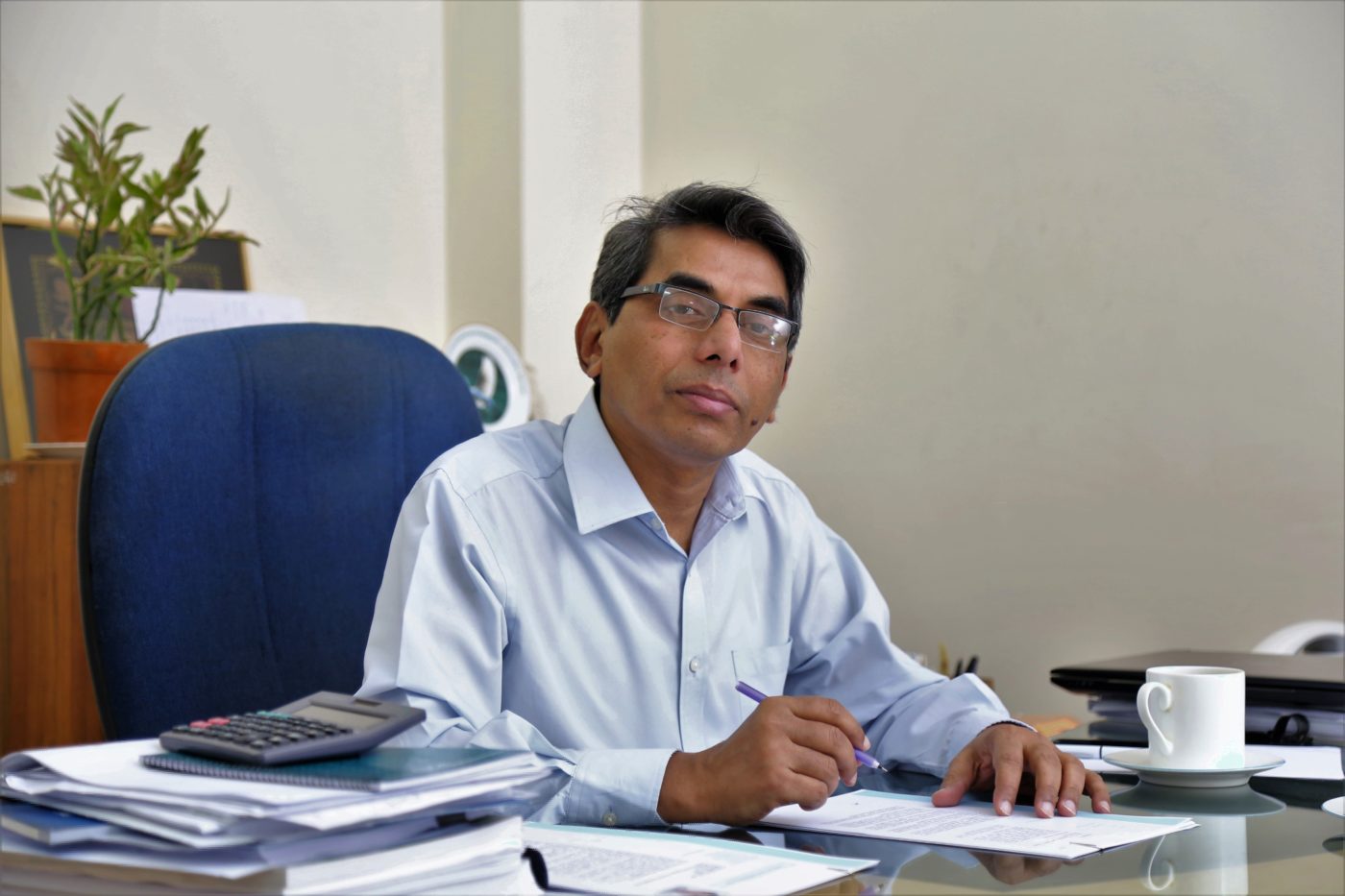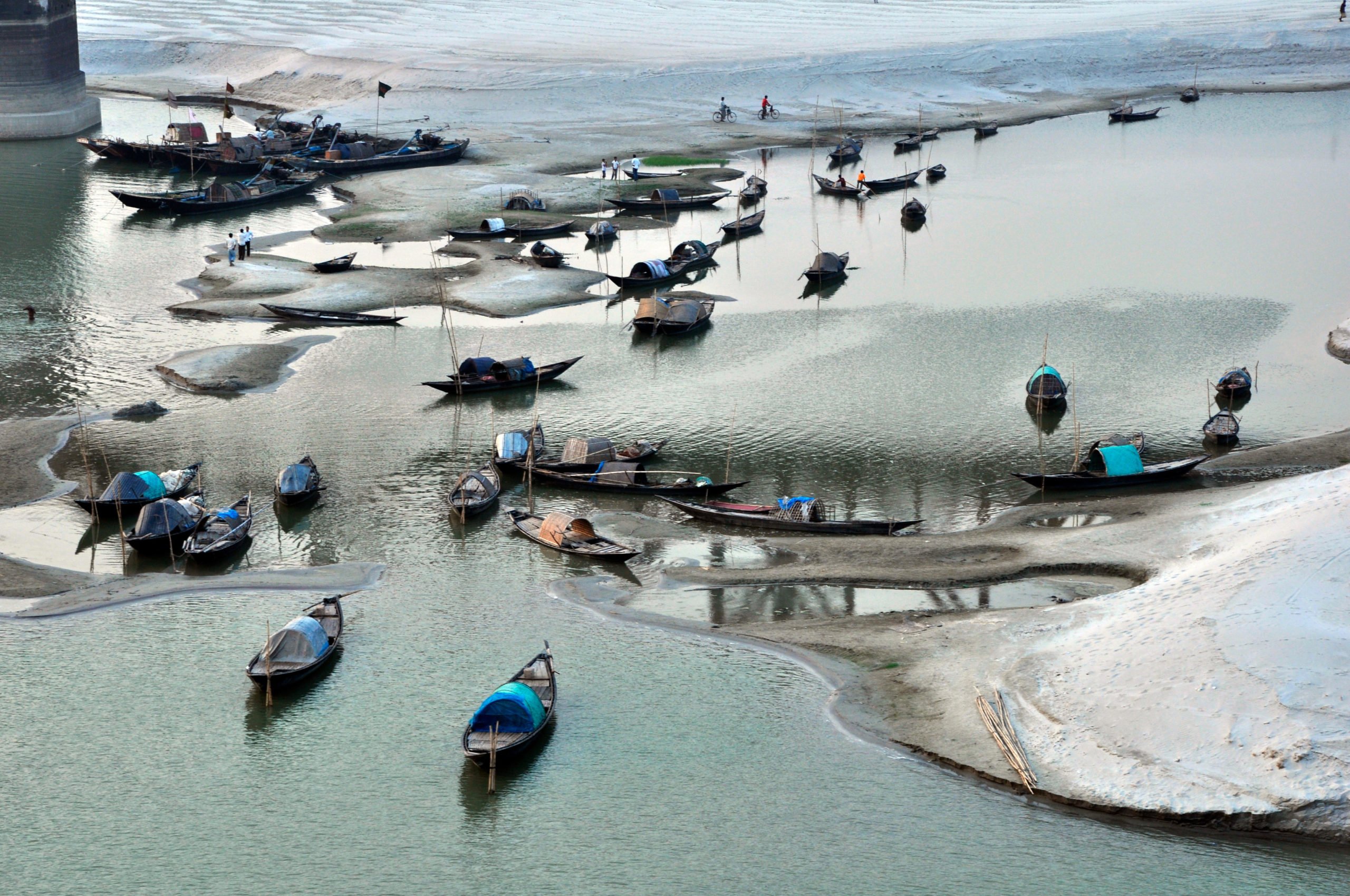
The Ganges Water Sharing Treaty was signed by India and Bangladesh in 1996. The 30-year treaty was the culmination of decades of negotiation, and specifies the minimum level of water flow to be shared by India with its downstream neighbour Bangladesh during the dry season, from January to May. The Ganges Treaty had been a principal demand of Bangladesh (then East Pakistan) ever since India started work on the Farakka barrage in 1962 – which was commissioned in 1975 – to divert water from the Ganga to the port of Kolkata.
Malik Fida A Khan is the executive director of the Center for Environmental and Geographic Information Services (CEGIS), a research institution created by the Bangladesh government. He is also a member of the National River Conservation Commission (NRCC), a state institution under the Ministry of Shipping, and has been a member of the Joint River Commission (JRC), a body established as an outcome of the 1972 Indo-Bangla Treaty of Friendship, Cooperation and Peace by the two countries.

He spoke with The Third Pole about Bangladesh’s experience with the treaty and prospects for future water cooperation. The interview has been edited for length and clarity.
I must say that the treaty is a success because this is the first time Bangladesh was able to establish our right to the river [waters]. Once the right is recognised, we can find other avenues for cooperation and management.

The Ganges Treaty was signed in 1996 on the basis of 30-year data. Both the countries agreed to ensure minimum water flow downstream during the dry season (January-May). But the basis of the treaty was the ‘quantum’ of water. Now is the time to consider other aspects of water regimes like environmental flow, climate change, navigation, economy and social aspects. Twenty-six years ago, these were not part of our negotiation because establishing the right on the water was the goal for Bangladesh.
To the best of my knowledge, we have received water from Farakka point according to the Ganges Treaty. You can find the specific data if you visit the Joint River Commission website. If we look at the data of the last 24 years, we will see that according to clause 2, the amount of water we are supposed to get, we mostly received that.

Fishing boats on the Padma River, as the Ganga is known in Bangladesh. The river has fallen in volume since India operationalised the Farakka barrage in 1975. (Image: Majority World CIC / Alamy Stock Photo)
There are two things we must understand. On both sides of the border, water demand has increased but the water availability in the river system has gone down. There might be many reasons for that like withdrawal, or diversion, of water upstream. As a lower riparian country, what we need to do is to study the relevant international laws and treaties first. It is urgent for both Bangladesh and India to do a lot of homework around these issues and share details with each other at expert level. For example, both the countries could work on the future demand. We all know that the demand is much higher than the availability of water in the river. That’s why we may not always have a win-win situation.
The treaty should not be based only on ‘a quantum of water’ and agricultural productivity. We need to also consider how both countries could help push back salinity.
The second thing is that both the countries should consider the environmental flow of the river while planning for another treaty. We have to remember that the impacts of climate change will not only affect Bangladesh river systems. Unless we consider the environmental flows of the Hooghly, Gorai and Meghna river systems, both India and Bangladesh will face challenges in the days to come.
From Bangladesh, we told our Indian counterparts that if we get more water than we need, maybe in the future we can divert that to India to save the Sundarbans in their part. The treaty should not be based only on ‘a quantum of water’ and agricultural productivity. We need to also consider how both countries could help push back salinity through the joint management of the Ganges.
We are in continuous discussion with India at the technical level. In Article 2 of the memorandum of understanding (MoU) signed by the heads of state of both countries in 2011, both countries agreed to work for basin-wide management of the joint rivers. But we are yet to start working together for the basin-wide management as there are few initial things that are still underway.
As a follow-up to the MoU, both countries have formed a technical committee to evaluate how Bangladesh can ensure the optimum use of the water, of which I am a member. We have already prepared terms of reference to do a joint study on that. We are thinking to initiate joint dredging of the rivers at our borders. If we can do that, I think we will be able to increase the water flow downstream. Both countries are planning joint studies, but the Covid situation has led to some delays. I think the situation has improved; we can now plan.
Any intervention on the run of the river is bad for the river and its ecosystem. Nevertheless, we do many engineering interventions in the rivers. The reason for the Farakka barrage was to keep the Kolkata port navigable and try to push back salinity in downstream West Bengal. The barrage was also necessary to divert water to keep the Kolkata port running during the dry seasons of the year (January-May). India constructed the Farakka barrage to divert 40,000 cubic feet of water per second to the Hooghly through a feeder canal.
Any such intervention requires strong management. Sedimentation [may lead to] operational problems while managing the gates of the barrage. If there is an acute shortage of water in the river system, then what would be the method of releasing water for downstream Bangladesh and West Bengal? The value of joint management comes through in this.
The barrage became operational in 1975, but do you think the morphological situation remains the same? The other thing we should think of is evaluating the performance of the barrage – how much it is contributing to the economy and the ecology. Unless we answer all these questions, there will be criticism around such engineering interventions. And the other thing is to make such reports public. If we could do such research and evaluations and let people know all these things, I think many concerns would be dealt with.
Both Ganges and Teesta issues are related to the Indian state of West Bengal. The former chief minister of West Bengal, Jyoti Basu, supported the Ganges Treaty and that is why we were able to sign the treaty. The central government is always in favour of such treaties or agreements, but they must value the opinion of the state government. The role of the state government, particularly its chief minister, Mamata Banerjee, is very important. We have to include her in our dialogue and technical discussion. It is important that she realises the importance of the treaty, her advisors need to be involved in the discussion around the Teesta.
In 1947, after Partition, management was divided, but the flow remains the same
For example, it would be really good if we could sit with eminent water experts like Professor Kalyan Rudra. We have to remember that these rivers are shared rivers. In 1947, after Partition, management was divided, but the flow remains the same.
The Indian central government should invite experts from West Bengal to the meetings when we discuss bilateral issues around water management. Otherwise, the state government will not be able to know what is happening around water management at the central level. On the Teesta treaty, both government at the JRC level and leadership level agree on the need of the treaty, but we need to have West Bengal on board to reach a consensus.
Please do not assume that there is no, or limited, coordination between us on the overall management of the water systems that we share. When we meet at the JRC level, we always highlight the directions of the 2011 MoU, which is basin-wide management. It is not practical to have agreements for each of the 54 rivers, it may take many years. So, we took a decision at the JRC on which rivers we would consider initially for basin-wide management. These include the Teesta, Mahananda, Dudhkumar, Dhorla, Feni, Monu and Khowai.
It is high time we focused on navigation, water quality, climate change, flood management, and resilience
We should do joint studies which look beyond the quantum of water at other benefits. If we only focus on the quantum of water, we must wait for many years to solve the issues around water management. But if we consider the benefits of sharing, we will then be able to solve a lot of disputed issues.
It is high time we focused on navigation, water quality, climate change, flood management, and resilience. It will not be a realistic solution if we only think of the five months of the dry season and how much water is diverted or withdrawn upstream.
And finally, there are a few new rivers identified as transboundary, but those rivers have not been listed. But if we can start working on the management of strategic rivers considering their importance on the ecosystems, we can then set an example of basin-wide management.
Bangladesh is always willing to discuss these issues, particularly multilaterally. But when we proposed to the Chinese that we should discuss the issue of basin-wide river management, they did not want to discuss this multilaterally. Up until now we have not been able to discuss the issue at Track I [inter-governmental] level. But there have been a number of dialogues and discussion at Track II [experts] or Track III [academics and NGOs] level.
I think we have opportunities to bring all the parties together to discuss at multilateral platforms, especially at Track I level. A regional conference or dialogue can be organised where policymakers from China, India, Bangladesh and Nepal can be invited to discuss the multilateral management of river basins.
The problem is with China and India. They want to discuss these issues at the bilateral level only. Bangladesh and Nepal are open to take part at any multilateral level. Even Bhutan is also willing to solve any disputed issues at a multilateral forum.
